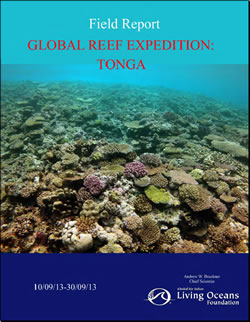Tonga Field Report
(2013)
Please find an excerpt of the full PDF below
Between September 10, 2013 – October 3, 2013 the Khaled bin Sultan Living Oceans Foundation conducted a research mission to Tonga as part of the Global Reef Expedition, focusing on coral reefs surrounding the islands in the Ha’apai group (Sep 11-21), Vava’u (Sep 22-28) and Niuaatoputapu (Sep 29-Oct 1). The mission included coral reef assessments, coral reef research, habitat mapping, and educational activities. This is the field report resulting from that mission.
Tonga Field Report
 Khaled bin Sultan Living Oceans Foundation
Khaled bin Sultan Living Oceans Foundation
September 2013
By Andrew W. Bruckner
The project was conducted in partnership with the Ministry of Lands, Environment, Climate Change & Natural Resources (MLECCNR), Ministry of Agriculture, Forests and Fisheries (MAFF) and Vava’u Environmental Protection Association (VEPA), with involvment of scientists from Nova Southeastern University, University of the Azores, University of the Philippines, NOAA/University of Miami, Atlantic and Gulf Rapid Reef Assessment Program (AGRRA), and the National Museum of Marine Biology and Aquarium (Taiwan). The objectives of the mission were to:
- Identify and characterize shallow marine habitats and develop habitat and bathymetric maps:
- Evaluate the composition, structure and health of coral reefs using a standardized assessment protocol;
- Evaluate the effects of environmental stressors on coral health and subcellular changes through biomarker expression;
- Assess the diversity, abundance and population structure of fishes, corals and other invertebrates, and algae, including commercially valuable species;
- Document the impacts of broad scale disturbances and patterns of recovery with emphasis on Tsunami damage in Niua;
- Measure ocean chemistry (pH) and effects on coral growth; and
- Characterize the types of symbionts in reef building corals and variations in their photosynthetic efficiency under different environmental conditions.
Groundtruthing: A total of 2212 sq km of WorldView 2 satellite imagery was acquired. To characterize shallow marine habitats, 524 videos (drop cameras) and 1.6 million soundings were taken across the three locations; covering a distance of 357 km. Georeferenced WorldView-2 imagery was used to plan bathymetric tracks to sample, and habitat locations of interest to drop video cameras. The bathymetric information will be used to calibrate a model which will assign a depth value to each pixel in the imagery data. Similarly, information from the camera drops will be used to assign a habitat type to the imagery data. Together, detailed maps of bathymetry and habitat type will be produced for the three locations visited.
Coral reef assessments: A total of 203 Fish transects, 365 benthic surveys, 311 coral assessments and 355 photo-transects were completed in 60 locations, from 5-30 m depth. The population structure and health of 27,308 corals (4 cm or larger) was assessed. Additional roving surveys for commercially important macroinvertebrates were conducted…